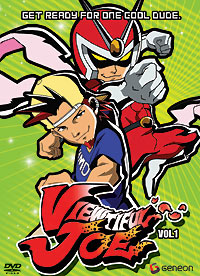Anime
Viewtiful Joe was produced by animation company Group TAC. The producer for the video game franchise, Atsushi Inaba, and his team gave Group TAC its character designs for the video games, as well as original character designs for the animated series. [13] The main cast includes Tomokazu Seki, Natsuko Kuwatani, Makoto Tsumura, Mayumi Asano, Shin-ichiro Miki and Banjō Ginga. [14]
The English version of the anime features voice acting by Jason Palmer, Philece Sampler, Mona Marshall, and Wendee Lee, among others. Bob Papenbrook, under the name John Smallberries, voiced Captain Blue for the show's first twenty-one English dubbed episodes. Papenbrook died on March 17, 2006, due to complications from a chronic lung condition, making Viewtiful Joe his final piece of work. [15] He was replaced by Paul St. Peter for the remainder of the dub.
The U.S. broadcast began with the fifth episode, with the first three episodes not being shown until a month later. [16] [17] The show's pilot was localized in the United States by phuuz entertainment. [18] A few censoring edits were made to the English dubbed version of Viewtiful Joe. In Brazil and Spain, the show was aired completely uncut. In the English version, the name of Joe's flying machine, Six Machine, was renamed in the English dub to Machine Six. There is speculation that it was renamed because its original name sounded close to the phrase "sex machine". Also, Six Majin was renamed to Robo-Six. Joe's middle finger was edited out in his henshin transformation sequence. Silvia's super hero alter ego is renamed from "Sexy Silvia" (which was also used in the games) to "Go-Go Silvia". Sprocket's jumpsuit is always zipped up completely, though it was originally unzipped (showing large amounts of cleavage) and one of her signature moves was to zip it up. This move was eliminated in the dub by cutting out the scenes, resulting in Sprocket having much less screen time than in the original.
Episodes of the series have been released on both DVD and UMD. [19] In North America, Geneon partnered with Kids Foot Locker to promote the show by including DVDs with purchases at the shoe retailer. [20]
CDs
The Japanese version of Viewtiful Joe features music composed by Takehiko Gokita and Yuusuke Hayashi. The show features two opening themes by the band SaGa. The song "Brighter Side" is used for the first thirty-eight episodes and the song "Spirit Awake" is used for the remaining episodes. "Brighter Side" is also used in the English version of the show. [21] The Japanese version also features the ending theme "And You" by SaGa for the first thirty-eight episodes, and "Tougenkyou" (also known as Shangri-La Village) by Amasia Landscape for the remainder. A 36-track CD was released by Geneon on February 7, 2006, and contains the anime's music, as well as the bonus track "Viewtiful World" from the first Viewtiful Joe game. [22]
SaGa released two CD singles of their vocal songs in Viewtiful Joe. The first one was released on March 30, 2005, and features both the Japanese and English versions of "Brighter Side" and "And You", as well as a DVD containing one music clip and the opening and ending Viewtiful Joe cinematics with the respective songs. [23] The second single was released on August 31, 2005, and features both language versions of the songs "Spirit Awake" and "Wonder", as well as a DVD music clip of the former. [24] In North America, a CD soundtrack was packaged with the first DVD volume. [25]
